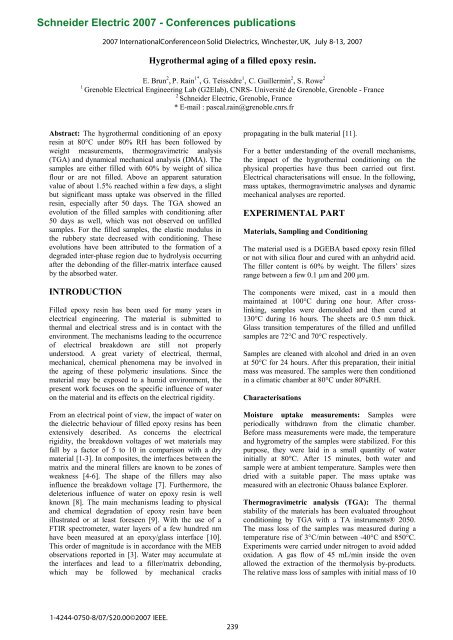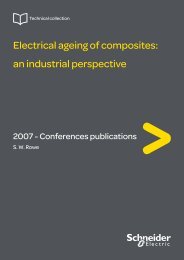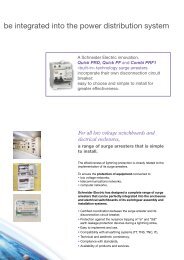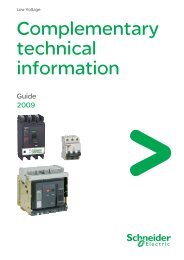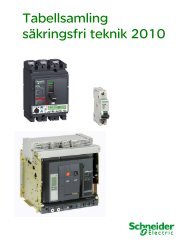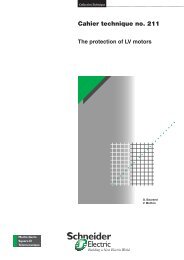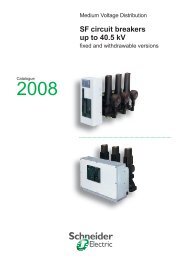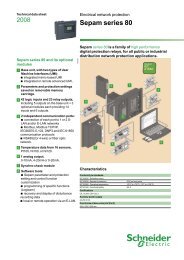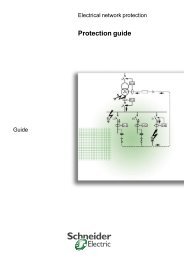Hygrothermal aging of a filled epoxy resin - Schneider Electric
Hygrothermal aging of a filled epoxy resin - Schneider Electric
Hygrothermal aging of a filled epoxy resin - Schneider Electric
Create successful ePaper yourself
Turn your PDF publications into a flip-book with our unique Google optimized e-Paper software.
<strong>Schneider</strong> <strong>Electric</strong> 2007 - Conferences publications<br />
2007 InternationalConferenceon Solid Dielectrics, Winchester, UK, July 8-13, 2007<br />
<strong>Hygrothermal</strong> <strong>aging</strong> <strong>of</strong> a <strong>filled</strong> <strong>epoxy</strong> <strong>resin</strong>.<br />
E. Brun 2 , P. Rain 1* , G. Teissèdre 1 , C. Guillermin 2 , S. Rowe 2<br />
1 Grenoble <strong>Electric</strong>al Engineering Lab (G2Elab), CNRS- Université de Grenoble, Grenoble - France<br />
2 <strong>Schneider</strong> <strong>Electric</strong>, Grenoble, France<br />
* E-mail : pascal.rain@grenoble.cnrs.fr<br />
Abstract: The hygrothermal conditioning <strong>of</strong> an <strong>epoxy</strong><br />
<strong>resin</strong> at 80°C under 80% RH has been followed by<br />
weight measurements, thermogravimetric analysis<br />
(TGA) and dynamical mechanical analysis (DMA). The<br />
samples are either <strong>filled</strong> with 60% by weight <strong>of</strong> silica<br />
flour or are not <strong>filled</strong>. Above an apparent saturation<br />
value <strong>of</strong> about 1.5% reached within a few days, a slight<br />
but significant mass uptake was observed in the <strong>filled</strong><br />
<strong>resin</strong>, especially after 50 days. The TGA showed an<br />
evolution <strong>of</strong> the <strong>filled</strong> samples with conditioning after<br />
50 days as well, which was not observed on un<strong>filled</strong><br />
samples. For the <strong>filled</strong> samples, the elastic modulus in<br />
the rubbery state decreased with conditioning. These<br />
evolutions have been attributed to the formation <strong>of</strong> a<br />
degraded inter-phase region due to hydrolysis occurring<br />
after the debonding <strong>of</strong> the filler-matrix interface caused<br />
by the absorbed water.<br />
INTRODUCTION<br />
Filled <strong>epoxy</strong> <strong>resin</strong> has been used for many years in<br />
electrical engineering. The material is submitted to<br />
thermal and electrical stress and is in contact with the<br />
environment. The mechanisms leading to the occurrence<br />
<strong>of</strong> electrical breakdown are still not properly<br />
understood. A great variety <strong>of</strong> electrical, thermal,<br />
mechanical, chemical phenomena may be involved in<br />
the ageing <strong>of</strong> these polymeric insulations. Since the<br />
material may be exposed to a humid environment, the<br />
present work focuses on the specific influence <strong>of</strong> water<br />
on the material and its effects on the electrical rigidity.<br />
From an electrical point <strong>of</strong> view, the impact <strong>of</strong> water on<br />
the dielectric behaviour <strong>of</strong> <strong>filled</strong> <strong>epoxy</strong> <strong>resin</strong>s has been<br />
extensively described. As concerns the electrical<br />
rigidity, the breakdown voltages <strong>of</strong> wet materials may<br />
fall by a factor <strong>of</strong> 5 to 10 in comparison with a dry<br />
material [1-3]. In composites, the interfaces between the<br />
matrix and the mineral fillers are known to be zones <strong>of</strong><br />
weakness [4-6]. The shape <strong>of</strong> the fillers may also<br />
influence the breakdown voltage [7]. Furthermore, the<br />
deleterious influence <strong>of</strong> water on <strong>epoxy</strong> <strong>resin</strong> is well<br />
known [8]. The main mechanisms leading to physical<br />
and chemical degradation <strong>of</strong> <strong>epoxy</strong> <strong>resin</strong> have been<br />
illustrated or at least foreseen [9]. With the use <strong>of</strong> a<br />
FTIR spectrometer, water layers <strong>of</strong> a few hundred nm<br />
have been measured at an <strong>epoxy</strong>/glass interface [10].<br />
This order <strong>of</strong> magnitude is in accordance with the MEB<br />
observations reported in [3]. Water may accumulate at<br />
the interfaces and lead to a filler/matrix debonding,<br />
which may be followed by mechanical cracks<br />
propagating in the bulk material [11].<br />
For a better understanding <strong>of</strong> the overall mechanisms,<br />
the impact <strong>of</strong> the hygrothermal conditioning on the<br />
physical properties have thus been carried out first.<br />
<strong>Electric</strong>al characterisations will ensue. In the following,<br />
mass uptakes, thermogravimetric analyses and dynamic<br />
mechanical analyses are reported.<br />
EXPERIMENTAL PART<br />
Materials, Sampling and Conditioning<br />
The material used is a DGEBA based <strong>epoxy</strong> <strong>resin</strong> <strong>filled</strong><br />
or not with silica flour and cured with an anhydrid acid.<br />
The filler content is 60% by weight. The fillers’ sizes<br />
range between a few 0.1 μm and 200 μm.<br />
The components were mixed, cast in a mould then<br />
maintained at 100°C during one hour. After crosslinking,<br />
samples were demoulded and then cured at<br />
130°C during 16 hours. The sheets are 0.5 mm thick.<br />
Glass transition temperatures <strong>of</strong> the <strong>filled</strong> and un<strong>filled</strong><br />
samples are 72°C and 70°C respectively.<br />
Samples are cleaned with alcohol and dried in an oven<br />
at 50°C for 24 hours. After this preparation, their initial<br />
mass was measured. The samples were then conditioned<br />
in a climatic chamber at 80°C under 80%RH.<br />
Characterisations<br />
Moisture uptake measurements: Samples were<br />
periodically withdrawn from the climatic chamber.<br />
Before mass measurements were made, the temperature<br />
and hygrometry <strong>of</strong> the samples were stabilized. For this<br />
purpose, they were laid in a small quantity <strong>of</strong> water<br />
initially at 80°C. After 15 minutes, both water and<br />
sample were at ambient temperature. Samples were then<br />
dried with a suitable paper. The mass uptake was<br />
measured with an electronic Ohauss balance Explorer.<br />
Thermogravimetric analysis (TGA): The thermal<br />
stability <strong>of</strong> the materials has been evaluated throughout<br />
conditioning by TGA with a TA instruments® 2050.<br />
The mass loss <strong>of</strong> the samples was measured during a<br />
temperature rise <strong>of</strong> 3°C/min between -40°C and 850°C.<br />
Experiments were carried under nitrogen to avoid added<br />
oxidation. A gas flow <strong>of</strong> 45 mL/min inside the oven<br />
allowed the extraction <strong>of</strong> the thermolysis by-products.<br />
The relative mass loss <strong>of</strong> samples with initial mass <strong>of</strong> 10<br />
1-4244-0750-8/07/$20.00©2007 IEEE.<br />
239


